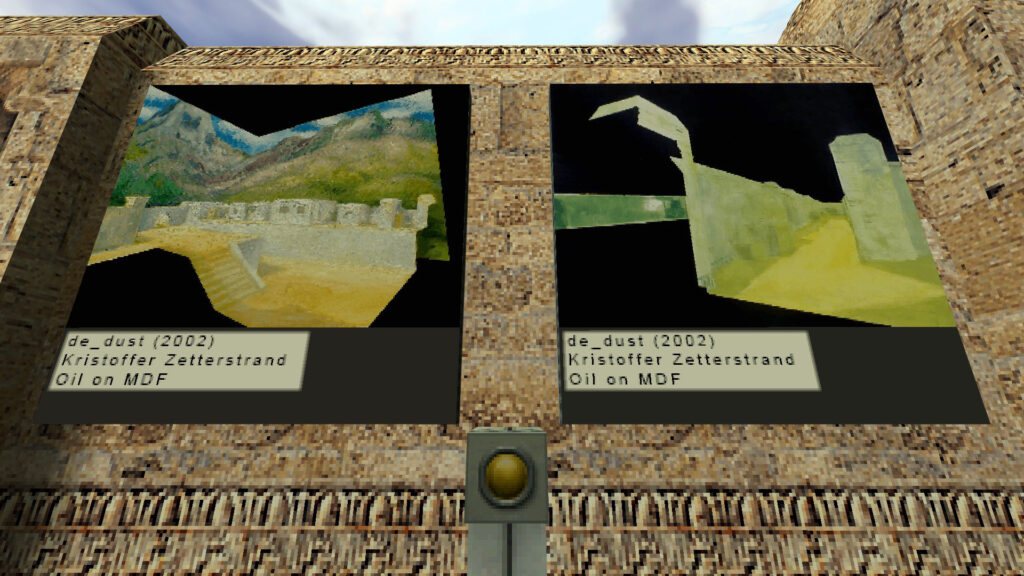Playces
Mathew Olson
Advisor: Kari Love
Video games, as an interactive art medium, are capable of creating a striking sense of place for audiences. I believe this characteristic has been under-explored in curatorial explorations of games as art objects, and in response created a series of works that focus on this idea and celebrate the craft of video game level design.

Abstract
How do we inhabit digital places? And how might experiencing a digital place–itself potentially an echo or simulacrum of a physical place–change how we understand ourselves? Playces is a collection of sculptural and digital works that explore these questions while celebrating the level design of first-person shooter video games of the late ‘90s and early 2000s. In that era, graphical demands and software were aligned such that small teams and even lone individuals regularly made levels or “maps” for games that reached millions of players. Playces also proposes alternative ways to incorporate the medium of video games in gallery settings; inspired by works from artists including Aram Bartholl and Cory Arcangel, the collection frames the maps-as-subject in ways that resist purely nostalgic responses and invite non-players to form new attachments to the medium of games.

Technical Details
Playces is comprised of three separate works:
"return_to_office," a set of vinyl-wrapped sculptures made of foamcore and plywood. Each modeled after an object found in the Counter-Strike's map cs_office designed by Alexander Manilov. The piece is also inspired by and serves as a response to Aram Bartholl's "Dust" (2005). The full-size chair presented a significant fabrication challenge, requiring unusual techniques to translate the geometry from the game to stable physical furniture.
"blood gulch," a kinetic sculpture featuring two moving statuettes modeled after characters from the machinima series "Red vs. Blue," a fan-made offshoot of the 2001 game Halo. Rooster Teeth, the production house formed off of the success of "Red vs. Blue," was acquired by Warner Bros. Discovery some time ago and was recently shut down; the movement of the statuettes recreates the software bug that made the series possible, while the inscriptions on the base modeled after part of Halo's Blood Gulch map point to Warner's mishandling of the cultural works it owns.
"wt_dust" is an in-engine walking tour of the Counter-Strike map de_dust, which for a time in the 2000s was far and away the most popular multiplayer map of any game in the world. Built atop the map's original geometry in Valve Software's GoldSrc engine, the tour content in "wt_dust" mixes the backstory of how Dave Johnston created the map with analysis of de_dust's reception and legacy.

Research/Context
The release of id Software's Doom (1993) ushered in the start of a movement lasting over a decade that saw video game enthusiasts entrusted with the same robust tools used by their developers to make complex “maps,” i.e. places, to explore in the games. In recent years, the practice of map-making and game modification has largely been co-opted by game publishers as “user-generated content” that can be sold or distributed mainly to the publisher’s benefit. Commercial incentives were not absent in the 90's and 2000's map making culture, but they primarily took the form map-making hobbyists going on to become professional game designers. Valve Software even acquired a number of hobbyist-made game modifications to launch successful franchises like Counter-Strike and Day of Defeat. Maps from this era were commonly made by individuals and thus were well suited to frames of analysis that look at authorial intent–by contrast, maps released for modern, more graphically demanding games are often the work of dozens of artists. Playces owes a debt to artists like Aram Bartholl, Kristoffer Zetterstrand, and Eva Mattes, who have previously created pieces inspired by popular maps. Those artists also buck the trend in museums and galleries of featuring games in ways that alienate non-players. Rather than focus on the artifice or the expected competitive behavior in these maps, the works in Playces are intended to highlight the ways these maps are designed and function for players as places in a real, deeply felt sense.



